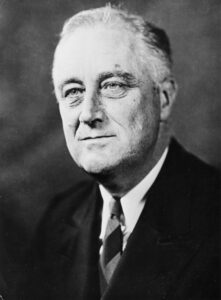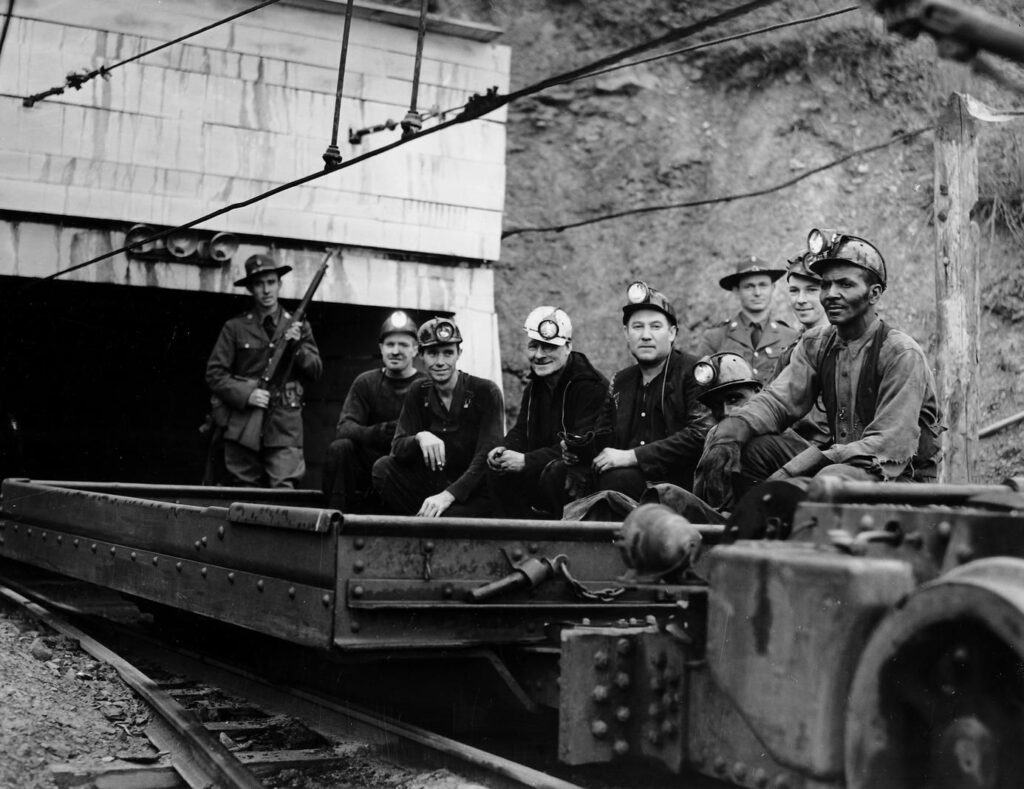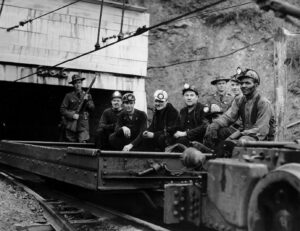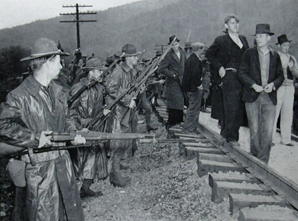Written by Joanna Adams Sergent
We return to our series on the Coal Wars of the United States with “Bloody Harlan” and the Battle for Evarts. These battles will end the Coal Wars proper. The Harlan County Coal Wars lasted from 1931-1939. However, the battle continues to this day. Before this war was over it is not known exactly how many miners, coal operators, deputies, and bosses would be killed. Sadly, the state and federal troops would occupy the county several times. However, after the dust was clear, the anti-labor coal country would end up being represented by unions.
The Miners Demands
Unlike the previous Coal Wars that took place in West Virginia with the Paint-Creek Strike of 1912 and Matewan that lasted for a year or two. The Harlan County Wars took on its own epic spin on the ongoing fight between labor disputes and the coal operators and owners lasting almost ten years. Mostly, the miners were fighting for improved working conditions, higher wages, and better housing options for their families. Miners also wanted the right to organize and have a union. Wanted to be able to spend their money at a store of their choice besides the Black Mountain Coal Company store. The miners could be fired if they refused to spend their paychecks only in the store.
Paternalism
The Kentucky mining camps still had the paternalism idea in their mists and the ever-independent Appalachian people were not having it. As discussed in a previous video.
Paternalism is the practice of people who have a business or other authority to restrict the freedoms of those who are subordinate to them. If those under them behave in an approved manner then they receive housing, work, food, and other “perks” of their position. If for example, they did not behave in the way the companies wanted them to, they could lose all their benefits up to and including their jobs.
What Started the Fight
The Great Depression of 1929 through the late 1930s hit Harlan County Kentucky. In response, the coal owners and operators decided to sell their fuel at below cost to increase the national dependency on coal. To prevent operating at a loss, on February 16, 1931, the Harlan County Coal Operators’ Association decided to cut all wages by ten percent. The decision caused unrest in the county among the miners.
This action did not go unnoticed by the labor unions and the United Mine Workers union decided to attempt to organize the already-impoverished labor force of the area. Attempts to organize led to the dismissal of employees who were suspected of having leanings toward the organization and having them evicted from their family homes.
The First Strike
The remaining workforce then went on strike as a sign of solidarity with those that were fired from their jobs. There were only nine hundred miners working and 5,800 miners were idle and striking during the first strike. This was thirteen percent of the workers showing up for their scheduled work times. Three Harlan County incorporated towns were not owned by the coal mines, they became a sanctuary for the evicted and starving miners. One of the towns that were a refuge was Evarts, Kentucky. Evarts welcomed the miners because it was filled with spurned politicians and business owners who wished to see the company stores and company men in political positions vanish.
The strikebreakers were under the protection of private mine guards. These guards were legally able to protect these men during their “off duty” time. They exercised their powers with impunity and operated under Sheriff J.H. Blair. Blair made it clear that he was on the side of the mine operators and the people of the county lost any illusion that the law enforcement would be impartial in this strike.
At first, there were little battles with gunshots being exchanged between the strikers and the private guards, and the local law enforcement agents. Strikebreakers were often beaten. On May 5, 1931, the Battle of Evarts began. It was the most violent attack of the Harlan County Coal wars and the most violence would only last fifteen minutes in total but would forever change the name to Bloody Harlan.

The Battle of Evarts
Miners laid in an ambush on the day of May 5, 1931, near the Evarts railroad crossing. The mining company had ordered a motorcade to deliver food and supplies to the strikebreakers known as “Scabs”. There were only three cars in the motorcade each of which contained a sheriff’s deputy.
As the motorcade approached a single shot rang out in the air. It is unclear who fired that shot but both sides claim that the other side did it. The motorcade stopped and the deputies got out of their cars to return fire. There were shots exchanged and all three deputies and one striker were killed. Over one thousand shots were exchanged during those fifteen minutes. One of the Deputies was Jim Daniels. Daniels was one of the most hated deputies in the county due to his anti-union views.
The Response
In response to the violence, the Kentucky National Guard was called upon and arrived for the first time in the county to try to stem the violence. Looking for protection by the Kentucky National Guard, many were surprised to find that they broke the picket lines instead.
On May 24, 1931, Sheriff Blair rescinded the miner’s right to assemble and tear-gassed a union rally. June 17th of that same year, the first strike was over as the last miner had returned to work. No concessions or deals were made between the two factions and the membership of the United Mine Workers union plummeted. The coal companies refused to back down from their positions and change anything.
Eight miners were sentenced to life in prison for the actions that were taken on May 5, 1931. They were convicted on charges of conspiracy to murder.
Help Refused
After the Battle of Evarts, the Red Cross and the United Mine Workers Union refused to help the striking men on the basis that it was now an industrial conflict that needed to be resolved internally. The United Mine Workers union also cited that they did not have the resources to help in the battle. No help came to those that were in starving situations due to no money to spend on food and no admittance to the company store unless they were gainfully employed by the coal mine.
Help Comes but Fails
With the opening left by the United Mine Workers union the openly Communist (NMU) National Miner’s Union tried to help the miners to organize. The radical ideology of the union began gaining some ground in the mountains. There were ten lodges that were chartered for the National Miner’s Union. However, they did make a greater effort than the United Mine Workers with relief as they opened soup kitchens around the county.
They made several attempts at holding strikes against the coal companies, but these failed in Harlan County. Their foothold there ultimately ended because the local clergy who were the labor organizers found out that the union was communist in nature and held animosity toward religion. This caused the clergy to denounce the union. Harry Simms, who was a Young Communist League organizer was killed in Harlan.
The Red Cross eventually became involved in the county along with several local charities. These charities began to give aid to blacklisted miners who were unable to find employment as the soup kitchens had closed once the NMU had closed its doors.

The National Industrial Recovery Act of June 16, 1933
As part of his New Deal, President Franklin Delano Roosevelt presented and had passed the National Industrial Act. This law was enacted to try to reverse the hardships to those who were out of a job because of the economic collapse of the Great Depression.
The Act was an attempt to restructure the industrial sector of the economy and to alleviate unemployment with a public works program. Under this Act, the right to organize in one’s workplace was granted as well as it outlawed any discrimination whether employed or seeking employment based on union membership.
Yellow-dog contracts (Contracts where the employees agreed to never organize into a union before they were employed with a coal company), company unions, blacklists, all tactics that were employed by the companies to bust up unions, and discrimination-based on union activity were all outlawed under this act.
Based on this new Act, from October 27, 1933, to March 31, 1935, the mines ran as “open shops”. An “open shop” is where union membership is allowed but not mandated to work at that location. At these locations, the mine wages began to be comparable to other jobs around the nation.

Cracks Form then Failure
Even though things were doing better for the unions in Harlan County, there was still civil unrest. The miners and the coal owners were still having disputes.
Sheriff Blair was voted out of his office in 1933 and died just a year later. Sheriff T. R. Middleton replaced Blair under the pro-union campaign platform.
These disputes were still brewing when on December 8, 1934, the United Mine Workers Union was threatened by deputies and mine bosses. The UMW union called in the National Guard to help them. Only to be escorted to the county line and told not to return.
The National Industrial Recovery Act only partially succeeded in accomplishing its stated goals when it was deemed unconstitutional by the Supreme Court on May 27, 1935, which was three weeks before the Act was set to expire.
With this Supreme Court ruling, all but one of the “open shops” in Harlan County went back to the previous mine operations.
The Wagner Act of 1935 (National Labor Relations Act or NLRA)
The Wagner Act of 1935 (National Labor Relations Act or NLRA) guaranteed the rights of workers to choose to organize. Outlining the legal framework for labor unions and management relations to improve the working conditions for workers. With the added protection for workers and the addition of collective bargaining between the workers and their employers.
There was an addition to where miners could choose their own representation for these negotiations. The Act also made a provision for a National Labor-Relations Board to designate a legal structure for the workers to conduct fair and legal elections of their officers and representatives.
Unrest in Harlan County
With the passage of these acts, there was unrest in Harlan County. In Harlan County on July 7, 1935, during a celebration of the Wagner Act, a group of disgruntled deputies severely beat up several miners and dispersed the crowd.
Troops had to be called into the county three times to maintain order.
On September 4, 1935, Harlan County Attorney Elmon Clay Middleton, age 31, was assassinated by a car bomb containing eighteen sticks of dynamite. Someone had planted dynamite in his automobile and when he started it up the car blew up. Middleton died on the scene.
It is thought that Middleton was assassinated for backing troops who were present in the County to protect the miners. Others claim that his death was caused by an election concerning slot machines into the county. Four men were arrested in connection with this murder.
On September 9, 1935, for the first time since the beginning of the war, troops were dispatched to Harlan County on behalf of the miners by the Governor of the State of Kentucky. There were constant beatings of the miners by the Sheriff’s deputies.
Aftermath
An investigation was conducted on Terrorism in the Kentucky Coal Fields. A Committee was formed and conducted by Activist Theodore Dreiser under the auspices of the National Committee for the Defense of Political Prisoners (NCDPP). The National Committee for the Defense of Political Prisoners (NCDPP) was of the American Communist Party.
Several folk singers and other artists toured the United States to raise money during the strikes. California labor activist Caroline Decker also raised money for the relief of the striking miner efforts.
Finally, in 1939, the coal companies agreed to allow unions in their coal mine operations. The United Mine Workers of America represented 400,000 miners at that point and promised miners safer work conditions and higher wages.
The unrest continues in Harlan and surrounding counties as there have been many strikes. The most memorable of those are 1964, 1966, 1969 (The West Virginia Black Lung strike that the miners won) 1971, and the 1974 Strikes. There are still ongoing strikes today and the violence in Harlan County Continues.
The latest unrest in Harlan County came when in July of 2019, Black jewel LLC filed for bankruptcy and liquidation. A federal bankruptcy judge ruled that the company could leave damages to the environment, abandon assets, and not pay the coal miner’s owed wages. From July 30, 2019, through September 28, 2019, coal miners and their families have blocked roads and railways demanding their payment. There is a suit still in litigation.
Ending Comments
Here at Kentucky Tennessee Living we fully support the coal miners and their families. When drafting these articles, I found that many things have not been taught to the future generations about the struggles for coal miner rights have been in the Appalachian Mountains. We hope that you have enjoyed our stop in Bloody Harlan and the history of the longest and still ongoing coal struggles of the United States.
For More Information on the Harlan County Wars and The Battle for Evarts please visit these sites.
Battle of Evarts
https://en.wikipedia.org/wiki/Battle_of_Evarts
National Industrial Recovery Act of 1933
https://socialwelfare.library.vcu.edu/new-deal/national-industrial-recovery-act-of-1933/
Battle of Evarts
https://pipiwiki.com/wiki/Battle_of_Evarts
Battle of Evarts
https://wiki2.org/en/Battle_of_Evarts
Harlan County War
https://en.wikipedia.org/wiki/Harlan_County_War
A Brief History of Harlan County, USA
https://labornotes.org/blogs/2019/08/brief-history-harlan-county-usa
Harlan County War
https://everipedia.org/Harlan_County_War
Background to the 1931-32 Strike
https://appalachiancenter.as.uky.edu/coal-strike/background-coal-strike
https://appalachiancenter.as.uky.edu/coal-strike/local-elite
https://appalachiancenter.as.uky.edu/coal-strike/new-york-writers
https://appalachiancenter.as.uky.edu/coal-strike/national-miners-union-and-other-radical-groups
More Information on the Harlan County War and The Battle of Evarts
The Wagner Act of 1935 (National Labor Relations Act)
https://www.thebalancecareers.com/the-wagner-act-of-1935-national-labor-relations-act-2060509#:~:text=%20The%20Wagner%20Act%20defines%20and%20prohibits%20five,or%20administration%20of%20a%20labor%20organization.%20More%20
BOMB IN AUTO KILLS KENTUCKY OFFICIAL; Harlan County Attorney Predicted Assassination for Backing Troops in Election.
https://www.nytimes.com/1935/09/05/archives/bomb-in-auto-kills-kentucky-official-harlan-county-attorney.html#:~:text=HARLAN%2C%20Ky.%2C%20Sept.%204%20%28AP%29.%20–%20The%20death,his%20automobile.%20View%20Full%20Article%20in%20Timesmachine%20%C2%BB
Elmon Clay Middleton
https://www.findagrave.com/memorial/70804679/elmon-clay-middleton
KENTUCKY HOLDS FOUR IN AUTO BOMB KILLING; Harlan Prosecutor’s Death Is Laid to His Fight Against Slot Machines.
https://www.nytimes.com/1935/09/06/archives/kentucky-holds-four-in-auto-bomb-killing-harlan-prosecutors-death.html
Blackjewel Bankruptcy Leaves Damaged Lands and Miner’s Compensation in Limbo
https://ohiovalleyresource.org/2021/03/22/blackjewel-bankruptcy-finalized/
Copyrighted through a Creative Commons License.
This work is licensed under a Creative Commons Attribution-NonCommercial-NoDerivatives 4.0 International License.
https://creativecommons.org/licenses/by-nc-nd/4.0/?fbclid=IwAR21nYphw4Dul-_EwuAmSWgzsvPLNwsMM0FtV75j0y-mGUHq-lCZjJxZot8
For more about us, you can visit our Facebook at:
https://www.facebook.com/kytnliving
Or on our YouTube Channel at:
https://www.youtube.com/channel/UCs0oV5gFzIS2JdMJ3HvTOgA
We have also joined Twitter at:
https://www.twitter.com/KYTNLiving
When we forget our past and who we are as a people, then we become who “they” say we are. ~~ David Sergent
I have attended the University of Kentucky. I have an Associates Degree from Hazard Community College and Technical School. I have also attended the University of Pikeville. I have taken several classes in Journalism as well as in the Appalachian History, Literature, and Sociology during my time at those schools.
I was born in Florida and grew up in Burdine, Kentucky. I have been married to David W. Sergent since May 4, 2013. I have two children and four grandchildren from a previous marriage. I currently live in Tennessee but my hope is to one day come back home to live in the beautiful mountains once more.






